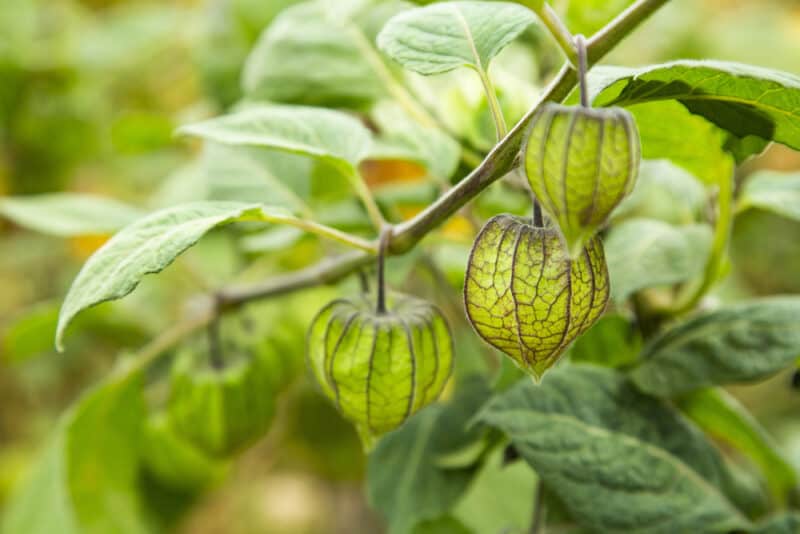How to grow and eat Cape Gooseberry (Physalis peruviana)
This post was most recently updated on May 16th, 2022
Cape gooseberries are botanically classified as Physalis peruviana. They are a sweet and tangy golden fruit belonging to the Solanaceae or nightshade family. Known by many names, including Goldenberry, Husk Cherry, Peruvian Ground Cherry, and Poha berry, Cape gooseberries are native to South America and have spread around the world, naturalizing in many regions.
Please read: This information is provided for educational purposes only and is not intended to treat, diagnose or prevent any disease. We encourage you to make your own health care decisions in partnership with a qualified health care professional.
This post contains affiliate links, this means at no extra cost to you, we make a commission from sales. Please read
our Disclosure Statement
What do Cape Gooseberries look like?
Cape gooseberries are not actually related at all to the common gooseberry. Physalis peruviana is their botanical name and they are actually part of the Solanaceae or nightshade family, making them closely related to tomatoes, tomatillos and peppers.
When are ripe?
The fruits form within a (calyx) that turns a pale golden and dries when the fruits are ready to harvest. The itself is small and somewhere between yellow and orange once ripe. Inside the looks a lot like a small .
Are perennial?
The grows as a small bush that is killed off by frosts. They will usually self readily, but if your climate has a short growing season, starting them inside might be advised.


Ground Cherry vs Cape Gooseberry
While this article treats them both the same, because they do taste similar, they can be used in the same recipes, and some people do use their names interchangeably. They are actually different plants.
Cape gooseberries (Physalis peruviana)
The cape gooseberry is also known as goldenberry, Aztec berry, Inca berry or Peruvian cherry. They are native to the tropical South America and grow to around 1.5m high. While treated as an annual in places that freeze, if you have it planted in a warm sheltered spot, plants can be pruned back by about one third after fruiting and they will continue to grow the next season.
Cape gooseberry fruit are ripe they are a bright yellow-orange colour and are about the size of a medium to large cherry tomato.
They have a delicious tangy, tropical flavor. Fruit will keep well in the husk for 3-4 weeks in a cool, dry, dark place.
Ground cherries (Physalis pruinosa)
Ground cherries are also known as Cossack pineapple are native to eastern North America. They have a lower growing habit than the cape gooseberries but can be eaten, cooked and stored in a similar manner. The fruit ripens to a golden/lemon color with a refreshing tart tangy flavor.
How do you grow ground cherries or cape gooseberries?
Growing ground cherries is very easy, and suitable for beginners. Usually these shrubs are grown as annuals, and once you have them, they will usually self-sow every year.
- Sow direct in garden, if you have a short season sow in early spring in pots inside to transplant after all frosts have gone. Best planted at soil temperatures between 10°C and 25°C (50°F and 77°F)
- Sow seed at a depth approximately three times the diameter of the seed.
- Space plants: 100 – 150 cm apart (40-60in)
- Harvest in 14-16 weeks when the weather is favourable.
Grows and fruits well in a pot or may be used as a border plant where the soft grey-green foliage can be used to offset other species. Great border filler, where the fruit can be accessed and freely eaten.


P. peruviana is an annual in temperate locations, but perennial in the tropics
If you have long winters or very cold springs, you can save the seeds in the same way you would save a tomato’s seeds and then you can grow seedlings in pots indoors ready to plant out after the frosts have passed.
They like well drained, well manured soil. They are tolerant to the heat as long as they get plenty of water, but a heavy frost will kill them.
They do not need staked or pruned, simply plant them in to the soil and water them as required to keep them moist but not soaking wet.
Once the papery husk of the fruit has dried, and the fruit inside is golden, they are ready to harvest.
What do Cape Gooseberries taste like?
The ripe cape gooseberry fruits have a sweet-tart flavor that is reminiscent of a sweet cherry tomato crossed with tangy notes of pineapple, mango, vanilla, strawberry, and Meyer lemon. It is hard to describe, but they are quite delicious and can be used in both sweet and savory dishes.


Can you eat raw?
Yes, varieties can be eaten raw, they are quite and refreshing. If you prefer sweet foods berries can be cooked with sugar to make stewed or jams and sauces for preserving or putting in pies or pastries.
Cooking or using Cape Gooseberries
Cape gooseberry husks are bitter and tough, so it is best to remove and discard them. When you first remove the husks, the skin of the fruit is waxy and can be a little sticky, simply wash this off before using in some warm water.
Cape gooseberries are tasty raw as a snack and make a fun addition to both green or fruit salads, but they really excel when they have been cooked.
They are nice dipped in something sweet like chocolate, fondant, icing, or rolled in sugar as a sweet treat.
They are very high in pectin, which also allows the berries to be cooked into preserves, compotes, and syrups for use in pies, crumbles, and tarts with great success.
For savory uses, Cape gooseberries can be used similarly to tomatoes. They can also be canned or dried for extended use.
For recipes to try using cape gooseberries try these
Nutritional value of Cape gooseberry:
The fruit is loaded with nutrients like vitamin A, B1, B2, B3 and C carbohydrates, phosphorus, protein, calcium, and iron, apart from their taste.
Benefits and uses of Cape gooseberry
Cape gooseberries have been used medicinally for a very long time by traditional cultures. There is some evidence of them being beneficial for some medical conditions, though to what extent they will be helpful for your own situation is between you and your health professional. Suggested benefits include:
- Improved cardiovascular system and lower blood pressure
- Improved arthritis
- Weight management
- Stronger eyesight
- Healthy pregnancy
- Stronger cognitive function
- Treats laryngitis and influenza
- Prevents fibrosis in kidney and liver
- Treats diabetes
- Supports the DNA Repair
- Boost the immune system
- Slow the spread of cancerous cells
- Accelerates wound healing
It is always recommended that you talk with your health care professional before undertaking any treatment.

